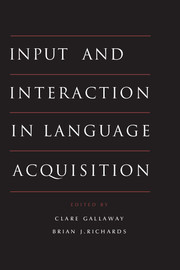Book contents
- Frontmatter
- Contents
- List of figures
- List of tables
- List of contributors
- Preface
- Introduction
- Part I General issues
- 1 The language of primary caregivers
- 2 The changing role of negative evidence in theories of language development
- 3 Crosslinguistic and crosscultural aspects of language addressed to children
- 4 Child-directed speech and influences on language acquisition: methodology and interpretation
- Part II Specific aspects of input and interaction
- Part III Types of language learner
- Conclusion
- References
- Author index
- Subject index
1 - The language of primary caregivers
Published online by Cambridge University Press: 05 June 2012
- Frontmatter
- Contents
- List of figures
- List of tables
- List of contributors
- Preface
- Introduction
- Part I General issues
- 1 The language of primary caregivers
- 2 The changing role of negative evidence in theories of language development
- 3 Crosslinguistic and crosscultural aspects of language addressed to children
- 4 Child-directed speech and influences on language acquisition: methodology and interpretation
- Part II Specific aspects of input and interaction
- Part III Types of language learner
- Conclusion
- References
- Author index
- Subject index
Summary
Introduction
It has been clear since the late 1960s and early 1970s that there are systematic differences between speech to children and speech among adults (Snow 1972; Phillips 1973; contributions to Snow and Ferguson 1977). Child-directed speech (CDS) tends to consist of short, well-formed utterances, to contain fewer false starts or hesitations, and to include fewer complex sentences and subordinate clauses (Snow 1972; Phillips 1973). It is characteristically higher in pitch, more exaggerated in intonation, and slower in tempo than speech among adults (Garnica 1977). It is also highly redundant, as reflected in the incidence of part or whole repetitions (Broen 1972; Snow 1972), much more closely tied to the immediate context (Phillips 1973; Snow 1977a), and employs a number of special discourse features which serve to involve the child in interaction and to clarify and upgrade the child's own contributions (Cross 1977; Snow 1977b).
Given that these differences appear to constitute adaptations to the child's limited linguistic ability, they have often been seen as a way of shifting the burden of explanation away from the sort of innate language acquisition device proposed by Chomsky (1965). However, while it is certainly true that any adequate theory of language acquisition must specify the way in which children make use of the input they receive, it has become increasingly clear that the relationship between child-directed speech and the child's acquisition of language is much less straightforward than a generally facilitative model of CDS would lead us to assume.
- Type
- Chapter
- Information
- Input and Interaction in Language Acquisition , pp. 15 - 37Publisher: Cambridge University PressPrint publication year: 1994
- 45
- Cited by



